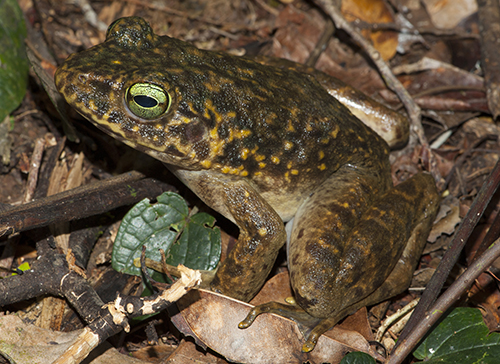Libby Roberts
11 June 2019: New Guinea is the last major centre of amphibian biodiversity that is free from the chytrid fungus … and it’s vital to either keep it that way, or be ready to deal with the fungus.
Chytrid is already wiping out more than 90 species of frog, and a paper recently published in Frontiers in Ecology and the Environment identifies five steps that can be taken to moderate the impact of the fungus if and when it makes its way to New Guinea.
Institute for Applied Ecology Distinguished Professor Dr Arthur Georges said preparation, prevention, detection, response and recovery are the five management steps examined in the paper.
“Given the likelihood of chytrid’s eventual arrival to New Guinea, we need to assess the relative imperilment in order to set priorities for conservation action, and quantify changes in frog communities to better understand and mitigate the pathogen’s potential impacts.
“We need to promote biosecurity and education to reduce the transmission and spread of the pathogen once it arrives, ultimately recusing frog populations and thereby preserving amphibian biodiversity,” said Dr Georges.
Chytrid fungus is responsible for the most widespread disease-induced decline and extinction in vertebrates to date.
Many Australian frog populations have declined since the 1970s because of chytrid – these frogs have close evolutionary and ecological affinities with the New Guinean frog fauna.
“This suggests that, as in Australia, dramatic declines will occur if the pathogen becomes established on the island,” Dr Georges said.
In the paper, an international consortium of 30 experts from Australia, the USA, China, Indonesia and Papua New Guinea, led by University alumna Dr Deborah Bower, call for urgent action.
“We call for urgent, unified, international and multidisciplinary action to prepare for the arrival of chytrid in New Guinea, to prevent or slow its spread within the island after it arrives, and to limit its impact on the island’s frog populations,” said Dr Georges.
The chytrid fungus has been able to spread rapidly due to the international pet trade. Due to this and to the fact that New Guinea is in close proximity to infected sites in Indonesia and Australia, the island is vulnerable to the introduction of the fungus.
“Rising levels of international commerce and cross-border movement of people elevate the risk of pathogen introduction, and tourism, logging, petroleum development and mining increase access to formerly remote locations,” said Dr Georges.
But Dr Georges said the absence of the fungus in New Guinea also offers researchers an opportunity.
“We can build local capacity in science, disease surveillance and diagnosis that will have broad relevance both for animal and public health,” he said.
In order to keep New Guinea a frog haven, implementation of an active management plan to keep the island’s frogs safe is key, which requires funding, planning and early coordinated efforts by a dedicated taskforce.
The full paper, Island of opportunity: can New Guinea protect amphibians from a globally emerging pathogen? can be found here.
Tags: University of Canberra; New Guinea; amphibian; frog; chytrid; fungus; Frontiers in Ecology and the Environment; Institute for Applied Ecology; Arthur Georges; Deborah Bower; international pet trade; tourism; logging; petroleum development; mining; Indonesia; Australia; Island of opportunity: can New Guinea protect amphibians from a globally emerging pathogen?



